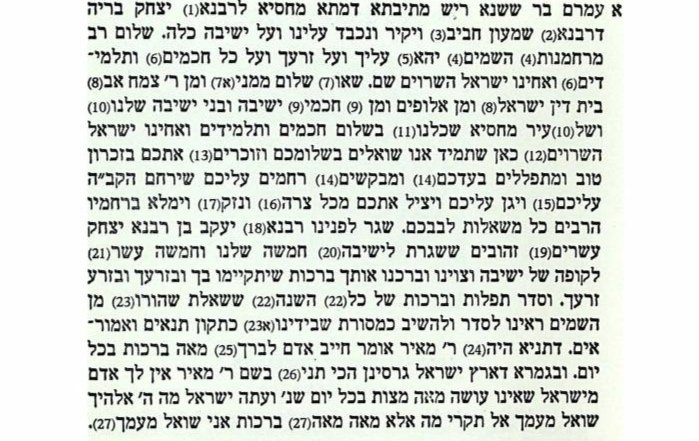Episode #1: The 1,200 Year Old Question
1,200 years ago, one of the oldest Jewish communities in the world asked a question. It was a question that would reverberate through history, and still impact us today. What does this simple act teach us about the role of questions and answers in Judaism, and how Jewish practice works and evolves across space and time?
In This Episode…
We learn about:
How Jews have asked questions throughout history, and how the answers have helped form unique cultures, rituals, and communities
How the once-great centre of Jewish life, in what is today’s Iraq, inspired communities around the world to this day
One of the oldest and longest running institutions of learning in human history
Are answers actually more important than questions?
How Jewish prayer evolved into what it is today
Why this podcast exists
[00:00] - Introduction: A letter from Persia to Spain
[02:25] - Opening Credits
[03:00] - A Question’s 5,000 Kilometre Journey
[05:48] - Ways to think about Jewish Prayer
[06:20] - The History of Jews Praying
[08:10] - Rav Amram & The Jewish Academy in Sura
[10:15] - Program Break & About this New Podcast
[11:20] - Rav Amram’s Beautiful Answer
[13:00] - The World’s Very First Jewish Prayerbook
[14:00] - A Spiritual Revolution: The Siddur’s Journey to Spain
[15:55] - She’eilot u’Teshuvot: The Literature of Questions and Answers
[17:00] - Introducing the Host and this Podcast
[17:45] - Asking Questions as a Jewish Constant
[18:16] - What Rav Amram’s Story Tells us about how Jewish Practice Works
[20:00] - Questions as a Journey to Transmit Stories, Values, and Ideas
[20:25] - How this Podcast Answers
[21:50] - Closing Credits
From this Episode…
A depiction of a rabbi - Rav Ashi - teaching at the Sura Academy. (Date
& artist unknown). From archives of the Museum of the Jewish People, Tel Aviv.
Learn more about how Jewish prayer works - and how “the texts and practices of prayer, while broadly common to all Jewish communities, vary according to local customs, ethnic origins, and ideologies.” (MyJewishLearning.com)
Read Rav Amram’s ben Sheshna’s full letter to the Jews of al-Andalus (today’s Spain) in English translation, and learn more about what’s included in it.
Jewish prayer takes on the specific flavour of its historical communities. Melodies, poetry, customs, and special prayers reflect the characteristics of the unique groups, ideologies, and parts of the world from which they emerge. In Hebrew each of these traditions are known as a Nusach (meaning: “version,” or “rite”). Learn more. (Wikipedia)
A street sign honouring Rav Amram Gaon in Tel Aviv, Israel.
Image by EnoshD (CC BY-SA 4.0)
More on the 2,500 year old Jewish communities of Persia and Iraq from the Iraqi Jewish Archive, including records of tens of thousands of documents, discovered in the flooded basement of the Iraqi intelligence headquarters.
Terms & Translations from the Episode
Torah (תורה): The first five books of the Hebrew Bible, forming the core spiritual text of Judaism which informs all narrative and ritual observance.
Tanakh (תנ׳׳ך): The Hebrew/Jewish Bible, of which the Torah is a part. It is an acronym for its three major sections - Torah, Nevi’im (Prophets), and Ketuvim (Writings).
Rav/Rabbi (רב/רבי): One of the primary Jewish spiritual leadership roles. Rav means “teacher” and Rabbi means “my teacher” - reflecting the traditional conception of the role. While today Rabbis fulfill many religious, spiritual, and ethical functions, historically they were viewed primarily as teachers and as legal adjudicators.
Ga’on (גאון): Literally means “genius,” but also a proper title that referred specifically to the heads of the Babylonian Jewish academies (yeshivas) that existed during the Abbasid Caliphate. They were generally accepted as spiritual leaders of the Jewish community worldwide in the early medieval era.
Yeshiva: (ישיבה): Literally means “a sitting,” but is used specifically to refer to academies of traditional Jewish learning. While today there are countless yeshivas worldwide, during the time of our episode, three yeshivas existed - in Sura (near today’s Baghdad Iraq), in Pumbedita (near today’s Fallujah, Iraq), and in Jerusalem. They were the highest Jewish educational institutions of the time, and were seen as the respective centres of Jewish legal thought and culture.
al-Andalus: The Muslim-ruled area of the Iberian Peninsula (today’s Spain and Portugal), circa 711-1492 CE.
Jews of Kochi, India: The oldest group of Jews in India, who claim roots dating to the time of King Solomon. Records as early as the 12th century make mention of Jews in southern India.
Siddur (סדור): A Jewish prayer book. The word siddur literally means “order.”
Sh’eilot u’T’shuvot (שאלות ותשובות): Literally means “Questions and Answers,” and refers to the genre of Jewish legal literature known as “Responsa,” which consists of practical questions posed to rabbinic authorities, and their subsequent answers. These collections often delineate the cultural contours of given communities. In traditionally observant communities, the responses (teshuvot) carry the weight of authoritative religious law. In liberal Jewish communities, the responses are typically viewed more as ethical guidelines or practical suggestions, but lacking enforceability.
Key Sources
The translation of Rav Amram’s letter is from Abe Silver at The Open Siddur Project, an open-source, community contributed archive for those sharing prayers and crafting their own prayerbooks. Accessed November 2021. Used under Creative Commons Attribution-ShareAlike (CC BY-SA) 4.0 International copyleft license.
The recording of the Jews of Kochi, India is courtesy of the Johanna L. Spector Papers and Audio-Visual Materials, The Library of the Jewish Theological Seminary, New York, (N.Y., ARC. 2008.03). The recording, along with others, is available in its entirety here.
Guest vocal talent by dear friends: in Aramaic/Hebrew by Rabbi Jason Fenster and in English by Aron Katz.















